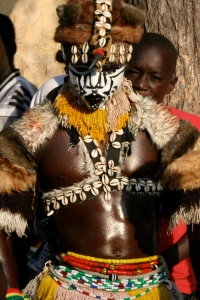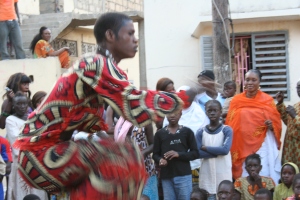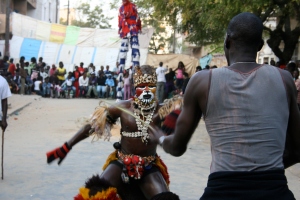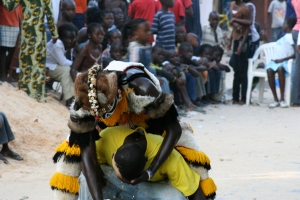Sabar Xoot Video Clip #1
January 30, 2011
Papa Chas plays Tagumbar before the rest of the group joins him for Ardin in this clip from the recording session for the Sabar Xoot CD.
Sing Sing Faye Ak Ay Rakim
January 29, 2011
Sabar Xoot, by Sing Sing Faye ak Ay Rakim, the newest release from the Géwël Tradition Project, is now available at CD Baby
(http://www.cdbaby.com/cd/singsingfayeakayrakim) . You can either purchase the CD or digital downloads. This is the original, traditional sabar sound, played by the elders of the Sing Sing family. This is not only great music, but it is great music with historic significance. And remember, all sales support the work of the Géwël Tradition Project.
The Simb of Senegal
January 16, 2011
Written by Mouhamad Faye
Translated from French by Nailah Randall Bellinger
Photographs, Video and Editing by Robert Sipho Faye Bellinger(1)
The Simb, or false lion, is an artistic creation dating back to the 1950’s. The concept was based on the idea of a transformation of man into a lion. This thematic motif originates in Africa, and specifically in Senegal.(2)
The Simb is a cultural manifestation that takes place once a year during the rainy season. Traditionally, there was only one person who made the event and it was to him that the genies told what to say and do. He has the ability to transform himself into a lion, possessing a magical formula. Over time two men took the responsibility to deliver the magic words, known as “Jat”: magic words that make the Simb fall into a trance. The two men have the power to awaken the Simb as well as order him to dance the rhythm played by the three drummers. Each ethnic group of Senegal delegated someone to represent from the four communes, Dakar, Gorée, Rufisque, and St. Louis.(3) These four communities have become the official host of the Simb ritual performance.
The Jat is spoken as follows:
Saalaali Mouhamad
Waalaali Mouhamad
Sakajàa Makajaà
Boul jaar ci kenn
jaaral ci man mii di ndey taw
wa bidig bidig wa badag badag
wa bantoum bantoum
wa anaa raki bantoum
wa diikoum diikoum
wa daakoum daakoum
wa dandakoumdanda sooré
Yaw njàay, man njaay,
Yaw taabou, man taabou
yaw Taábou dou laal moroómou Taáboum
Aie Jinéé, Hjaáy!!!
After the spoken words of the Jat, the Simb falls into another trance and lies down to sleep on the ground. In time the community of participants gather around him to create the Guéew, the sacred circle for the event, and the dance begins. Each tribe or ethnic group makes a performance of their traditional dance. Following the presentations of all the ethnic groups the men in charge of the Jat recite new words that awaken the Simb. The event then continues way into the late hours of the night.
Presently, this ritual of the false lion is no longer practiced as it was in the past. Sometimes the false lions appear in numbers of eight, and wear costumes that cover the head with paints of red, yellow, and black around the eyes, and costumes for their chest, back, waist, thighs and feet. The earlier false lions were covered with a handmade cloth made by the weavers, the Manjaques(4). The costume is completed with the dressing of gris-gris of different types such as “the Toul” (the one wearing it will not be wounded by a bullet shot from a pistol), or “the Xabtal” (those wearing this gris-gris have an ability to perform the extraordinary and are known to have jumped from five story buildings without injury, crunch bottle shards, and walk on fire without being burned).
Today the Simb is a traditional gathering performed by five male simb and two “female” simb dancers. The Gainde bu Jigeen(5) is a simb dressed up as a woman and represents the wife of the great lion. They perform along with a Thiakaaba(6), like in the circus, mounted up on two long sticks, two meters in length, that represent the legs of the one mounted.
The Simb of the present day begins three to four hours after mid-day and can last for three to four days. The false lions perform choreography that is repeated by the drummers or percussionists. The dances accompany the drum rhythms which are commonly called “Bakk”(7) of which there are several versions. The Simb takes place in the street and is a paid event.(8)
ENDNOTES
- The author, Mouhamad Faye, is a grand nephew of Sing SIng Faye, the present Baj Géwël of Dakar. Efforts were made in the translating and editing to stay as close to the original text as possible. The endnotes were added by the editor for additional clarity.
- The lion motif is very important in Senegalese culture and carries many layers of meaning religiously and secularly.
- These four towns were the four main settlements of the French during the colonial era. In the 1870s the inhabitants of these communities were given the status of French citizens while the rest of the population remained “subjects”.
- The Manjaque are an ethnic group that is found in Senegal. They are known as weavers and can be seen in Dakar with their looms set up, making traditional cloth.
- The “Simb” is a male activity and though women attend the event all of the dancers in a Simb are male. The part of the Gaindee bu Jigeen, or the lions wives, is danced by men dressed as women.
- Thiakaaba is often known in the west as Moko Jumbi.
- A Bakk is a rhythmic composition that can be quite intricate. The Simb dance to Bakks that are created specifically for them.
- Today the Simb is really an event that is popular among the children and it is generally geared towards them. However, everyone in the community attends the Simb from children to adults, and on occasion, elders.
The Géwël Tradition Writer’s Workshop
January 10, 2011
One portion of the Géwël Tradition Project has been the development of a Writer’s Workshop to work with some of the younger géwëls. The goal of the workshop is to provide young géwëls the opportunity to write about the Géwël Tradition. This provides an opportunity for a presentation of the géwël tradition with the particular insights and understandings of those who have inherited and thus grown up in this tradition. In addition to their viewpoints, the essays are in their own voices.
The first piece from the Géwël Tradition Project Writer’s Workshop will be the next entry published. The article is about the Simb, or false lion event in Senegal, written by Mouhamad Faye who is a student at the University of Chiekh Anta Diop in Dakar, Senegal where he is studying Literature and Theater.
Stay tuned.






















